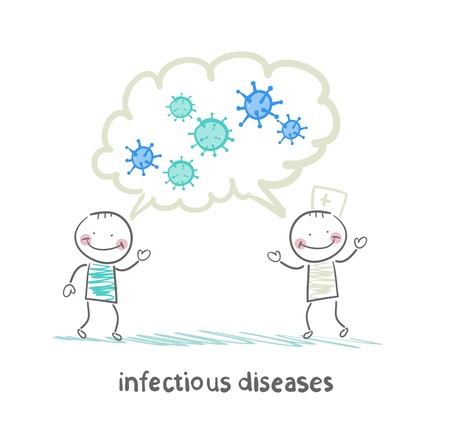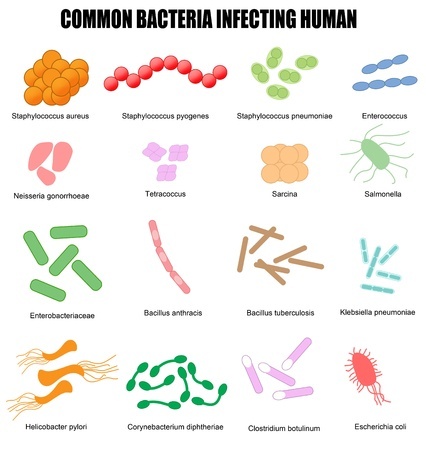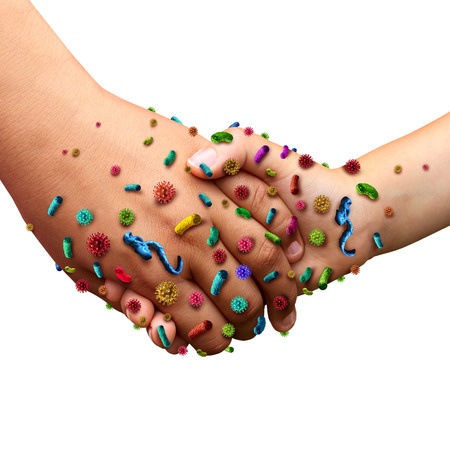An ongoing dialogue on HIV/AIDS, infectious diseases,
April 5th, 2017
Here’s What Happens When You Search “Infectious Diseases” on a Stock Photo Site
Everyone knows a stock image when they see one. The people don’t look real, the activities are staged, and everything has an air-brushed, frozen quality that screams, “This is not a real thing, but we need some copyright-free graphics and this is the best we can do.”
Strangely depersonalized group photos, animals in human activities, and computer-created illustrations just one step up from Clip Art dominate the stock image sites.
Take this one, for example:
Who are these people? They’re in a boring white room, so why are they so happy? The woman on the far left, where did she get that hat? Is that dog as uncomfortable as it looks? The jeans — are they truly worn out like that, or is this a Photoshop acid-wash effect? What’s with the guys and the tongues?
Anyway, thanks to the largesse of the the generous publishers of this site — who are far more famous for their signature product, abbreviated N-E-J-M, than for this silliness — I have access to tons of stock photos. Literally 69 million, if you believe the banner on my (secret) source.
Now 69 million images is a lot to get through, especially if you have to milk the cow, pick up the kids after school, make dinner, and save that poor little dog from that black-hatted woman’s evil clutches.
Fortunately, there’s also a search box to help narrow down things a bit.
And just for fun, I searched “Infectious Diseases”. Here are a select few from the 10,737 that popped up with this query.
Let’s lead off with one for the children:
- Hmm, what have we here? Two kids (assume they’re kids) playing outside on grassy lawn, sharing … “infectious diseases” (lower-case). All in the same cartoon word balloon.
- Is this a harkening back to the days of Chicken Pox Parties? Imagine the Evite.
- Come to think of it, those virions look very influenza-like — let’s hope they’re not H7N9.
- Of course the kids are happy because they’re developing a healthy immune system. More support for the “hygiene hypothesis”!
- Note the hat on the kid on the right, who has chosen a very old fashioned way to dress up as a nurse.
On to Image #2, a workplace scene:
Scene: Inside an office park, Somewheresville, USA. Three young, attractive professionals are walking down the hall reviewing a very important contract, which is kept in a red folder. The topic shifts to their colleague Matt, whom they spot in the distance.
KARLA: Hey, there’s Matt! Can we hide? He has the nastiest cold.
JEFF: I know. I have the cubicle next to him, it’s disgusting. I hear him expelling gunk from his sinuses every five minutes.
CRISTIN: Isn’t there anything we can do?
KARLA: Remember when they thought a camel had MERS in our local zoo? I still have the masks they gave us.
JEFF: Great idea, Karla!
CRISTIN: Here he comes — quick, pass them out!
Matt approaches, and all three put on their surgical masks. He then sneezes noisily into his handkerchief. Screen fades to black.
Now for #3, an educational graphic:
Courtesy of a graphic designer named “Roxanne”, I bring you this educational chart, described by her as a “Vector illustration intended for basic medical education (clinics & schools).” But before you use it, here are few important corrections, courtesy of a pedantic specialist in Infectious Diseases.
- Change the title to “Common Bacteria Infecting Human Beings” or “…Infecting People“. English, you know.
- For bacteria #2 and #3, it’s Streptococcus not Staphylococcus. C’mon Roxanne, you knew that.
- “Tetracoccus” and “Sarcina” as “Common Bacteria Infecting Human (Beings)?” You might need Dr. Google to help identify these two (I did), as both are exceedingly rare human pathogens. In other words, they will not be on your ID boards.
- If Bacillus tuberculosis is a name for Mycobacterium tuberculosis anywhere on the planet (besides this poster), this is the first I’m hearing of it.
And Roxanne, after you make those corrections, you can send the royalty check to my home address.
Wrapping up with #4:
… and #5:
Yuck. Highly unlikely we’ll be seeing either of these images on a T-shirt or mug anytime soon.
But maybe that’s just me.








I had to wash my hands after touching the screen.
Other image sources aren’t much better… you’ve hit upon a much needed niche, quality medical stock photos! I can see it now, NEJM Medical Images!
I run into this problem all the time, when I am looking for images for my lectures.
That handshake image made me think, “Ow!”. It looks like they stuck on some plastic things with… push pins? Or glue? I could sort of see that becoming the next teen fad.
Thinking about why tetracoccus and sarcina are included, the clue is in the fact that Roxanne is a graphic designer, and these bacteria are pretty, as opposed to, say, good old H. influenzae, which as can be seen in #4 and #5, has a shape only a mother could love….
While on the subject of looks, I had no idea that E. coli was so attractive… and what the heck are those things that look like pretzels with tails?
For the lay person, the colorful bacteria may be accepted as real. And that’s bad. The lay person, however uneducated in laboratory evidence, needs accurate representations to understand the importance of hand washing and covering the mouth during a cough or sneeze. Indeed there’s no guarantee the clinician practices better infection control!
The workplace photo is extreme and comical and is of no help to day to day infection prevention.
Is the point of the photo with underweight women and interested men to caution against group sex? What is the point anyway?
Better more accurate stock photos are needed to inform, educate and remind.
The NEJM might create a stock video that show shoes and hands entering and exiting restrooms to show that people often do not wash hands; and a video with hands on a buffet line shunning use of forks and spoons to grab instead.